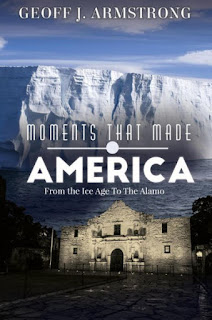Dear Reader…
You are about to embark on an
interesting journey: a voyage into the heart and soul of the most powerful
country the world has ever known, but what you should know, before you start
reading, is that based on simple logic, the United States shouldn’t exist at
all, or if it managed to come into being, it should be unrecognizable.
Suppose, for example, the giant
supercontinent we call Pangea, never experienced the massive continental
fracture that severed the huge landmass now known as North America and sent it
sailing off to the west where it was able to develop its own unique environment
and eventually its own independent culture separate from the geography and
cultures that would become Europe, Asia and Africa. However, one doesn’t have
to travel back that far to uncover moments that profoundly and forever changed
what America
would become. Imagine America
without George Washington. That nearly happened more than once. Early in his
career, just before the constant antagonism between the British and French over
control of North America broke out into the open conflict known as the French
and Indian wars, while serving as a young colonial officer under the British,
Washington and a force of about 1200 British soldiers and officers were
ambushed while reconnoitering a French fort in the Ohio River Valley. As usual,
the French and the Native American allies targeted the officers. At six-foot
four and on horseback, Washington
was a prime target. He was hit four times and two horses were shot out from
under him. The musket balls penetrated his clothing, but not a single one
touched him. Washington was the
only mounted officer who survived the ambush. He managed to rally the surviving
men and lead them to safety. Had he died that day the America
we know would not exist and the entire history of North America,
perhaps the world, would have been different.
What would America
be if the Union had lost the Civil War? Looking back
from our vantage point of more than 150 years, it can seem as if the outcome of
that blood-soaked war was inevitable, but it all might have hinged on one
seemingly small decision by one Confederate general at the Battle of
Gettysburg. On the second day of that iconic battle, General Robert E. Lee sent
an officer to tell General Richard Ewell to take control of a small hill and
the adjacent high ground. Contemporary testimony says that Lee’s orders were
more of a suggestion and Ewell, seeing that his men had been pushed to their
physical limits, decided not to take the high ground. Before the day was out,
Union forces occupied that vital high ground and had covered it with cannons
and Union troops. Finally realizing its mistake, Lee launched a massive assault
that will be remembered forever as “Pickett’s Charge”. The South lost 5000 men
that day and a final chance to invade Washington.
Imagine modern America
if the Union capital had been taken by the Confederacy and Lincoln
thrown into prison?
The story of the United
States is packed with such moments and many
even stranger, such as the tornado that struck Washington,
DC during the War of 1812 just as the
British tried to burn it.
Moments that Made America is a
planned series of three books that tell the story of the United
States by focusing on those pivotal turning points or tipping points that
have defined and shaped America. The first book in the series, “Moments that Made America: From the Ice Age to the Alamo” is available now, the second book, “Moments that Made America: From Civil War to Superpower” will be
out in June this year. The final volume “Moments that Made America: The American Century” will be out in
the new year.
About the Author
Geoff Armstrong began his teaching career in 1965 after
receiving a teaching diploma from McGill
University’s Macdonald
College. He earned a Bachelor of
Arts degree from Montreal’s Concordia
University in 1967 where his major
field of study was history. Armstrong credits writers such as Bruce Catton, and
Thomas B. Costain, as well as the encouragement of his father who had little
formal education, but a deep love of reading and of history, as the inspiration
for his own life-long interest.
Throughout a 25-year teaching career he taught history at
several grade levels and learned quickly that to reach the hearts of his
students, history had to be made immediately and deeply relevant and
accessible: that some event that took place centuries before those students
were born had a direct and profound influence on every aspect their lives. He
also learned that talking down or writing down to his students was a recipe for
defeat. It is this awareness, shaped by a quarter century of teaching and
countless questions by thousands of intelligent young people that has informed
and shaped his writing.
His latest book is Moments
That Made America: From the Ice Age to the Alamo.
You can visit his website at www.MomentsThatMadeAmerica.com.
About the Book:
From its geological birth during the breakup of the Pangaea
supercontinent millions of years ago, through the nation-shaping key events
that led to its political independence from the British superpower, and other
crucial, sometimes miraculous events that worked to create the nation, Moments That Made America: From the Ice Age
to the Alamo explores those defining moments, both tragic and inspirational
that profoundly shaped the nation and its people - crucial turning points that
worked inexorably to mold and make America. These pivotal "tipping"
events formed America's geographical, sociological,
political and historical landscape. Part 1 culminates with the discovery of
gold in California and the role it played in fulfilling America’s dream of Manifest Destiny.





No comments:
Post a Comment